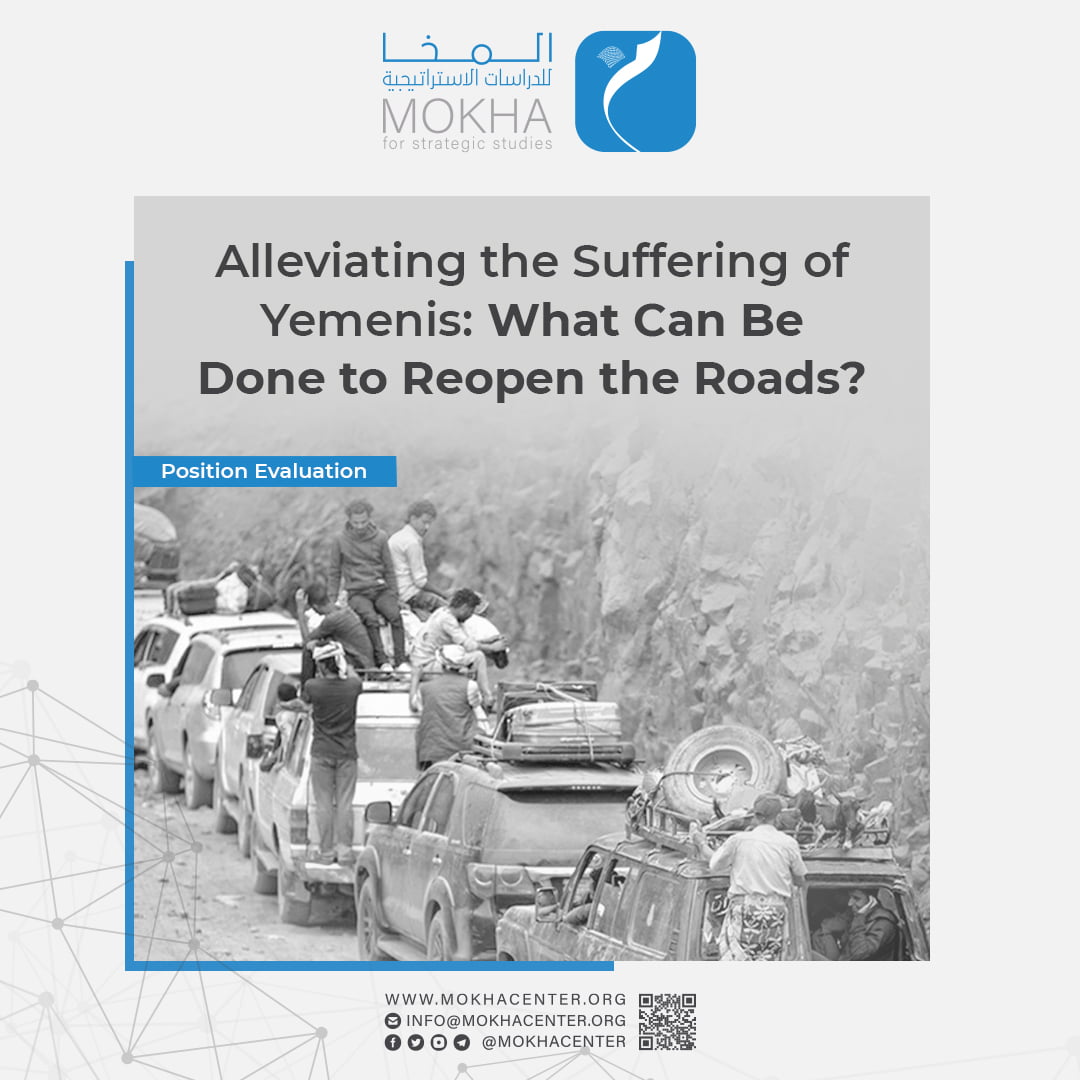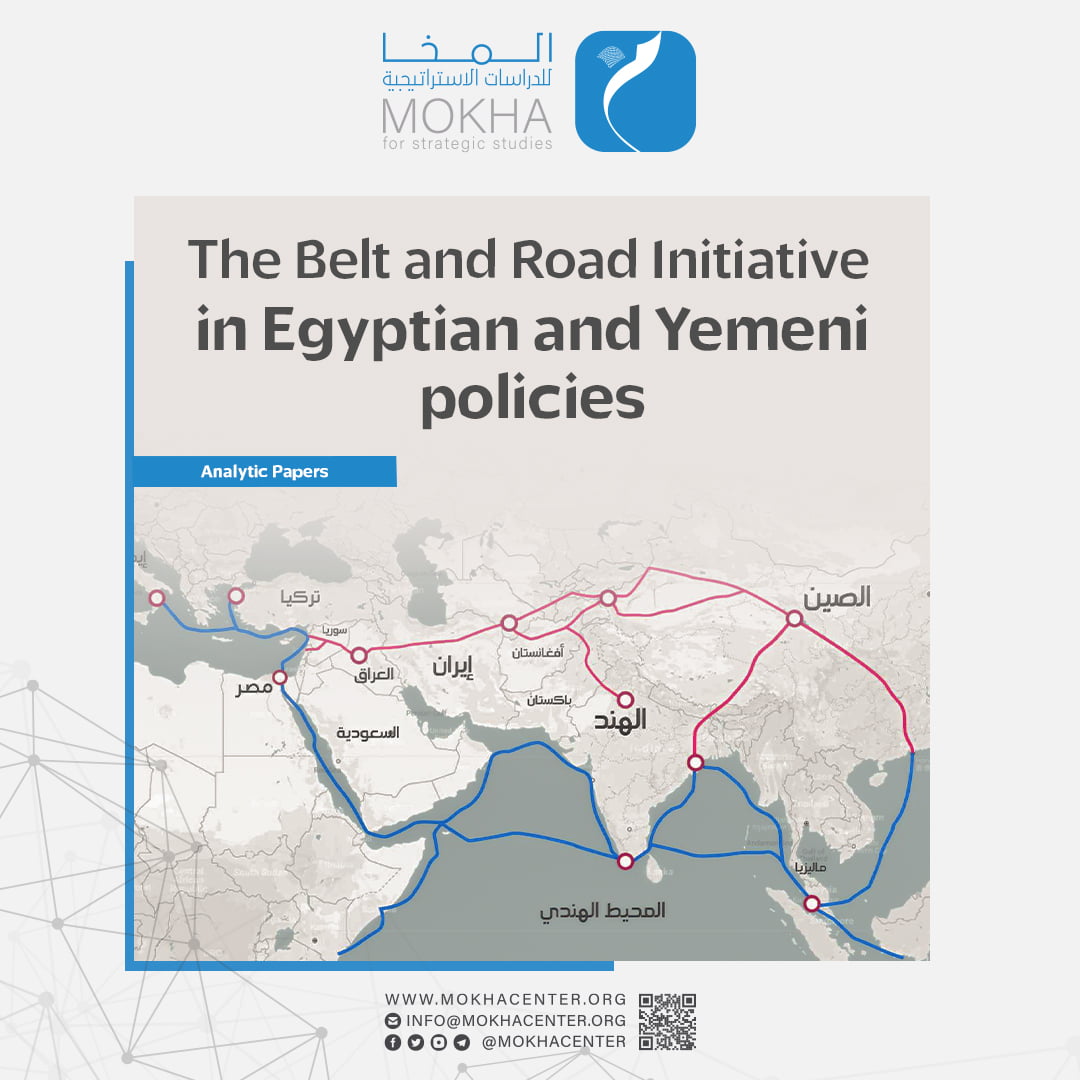Alleviating the Suffering of Yemenis: What Can Be Done to Reopen the Roads?

| Getting your Trinity Audio player ready... |
In light of recent political and media clashes between the legitimate government and the Houthis regarding the reopening of roads closed due to the conflict in Yemen, there has been a surge in public demands to address the escalating suffering of citizens forced to take longer, riskier routes. While efforts such as the initiative by Major General Sultan Al-Arada to open the road connecting Ma’rib to Sana’a offer a glimmer of hope, the response from the opposing party has been disappointing, exacerbating the plight of Yemenis.
Addressing the pressing need to alleviate widespread suffering requires a pragmatic and nuanced approach to this complex issue. This paper aims to explore the current state of road-reopening initiatives and to offer recommendations to policymakers for a realistic and adaptable strategy.
Despite the circumstantial and evasive behavior of the Houthis, the urgency of the situation demands a breakthrough. It is imperative to acknowledge the multifaceted challenges and intricacies of the situation while responding effectively to the profound suffering experienced by Yemeni citizens.
This paper delves into the efforts undertaken to reopen closed roads and presents actionable recommendations for policymakers to navigate this intricate landscape with sensitivity and pragmatism.
General Background:
The ongoing conflict, spanning nearly nine years, has resulted in the closure of key roads situated in conflict zones between the opposing factions. Since 2015, the Houthis have swiftly imposed a stringent blockade on Taiz, effectively sealing off the city by shutting down all three primary routes leading to and from its northwestern, northern and eastern entrances. It wasn’t until March 2016 that the popular resistance managed to partially reopen one of these routes on the western front, albeit the rest of the city remained besieged, with other access routes remaining severed to this day.
To traverse to or from Taiz, residents are compelled to navigate the rugged, unpaved mountain path of Al-Aqroud, spanning over 60 kilometers. This route winds through narrow passages, featuring numerous sharp turns and dotted with multiple government and Houthi checkpoints along the way.
Similar circumstances unfolded in other regions as well. The vital road connecting Sana’a and Ma’rib via the Nihm checkpoint suffered closure, stretching over a distance of 173 kilometers and typically requiring about three hours to traverse. Instead, alternative routes were established, such as the Dhamar–Al-Bayda–Ma’rib route, which not only takes over 16 hours to traverse but is also fraught with hardships and significant risks, with numerous security checkpoints on both ends, subjecting travelers to frequent inspections. Alternatively, the Al-Jawf–Ma’rib route presents its own challenges, cutting through desert terrain and posing various hazards. Presently, travelers opt for this route to reach the Saudi border, primarily through the Al-Wadiah port, the sole remaining connection point facilitating the movement of thousands of citizens and goods between Yemen and Saudi Arabia.
In 2015, the crucial Sana’a–Al Dhale–Aden Road, a lifeline for the country, fell prey to closure. In 2019, the Houthis destroyed a pivotal bridge on this route, thwarting subsequent attempts to reopen it, including an initiative led by the Southern Transitional Council forces in July 2022. Additionally, numerous other roads were severed in conflict zones across several governorates, like Saada, Al-Jawf, Hajjah, Al-Hudaydah and Al-Bayda.
Moreover, due to military clashes between the National Army and UAE-backed Transitional Council forces since 2018, several roads in some governorates, including Lahj, Abyan, Al Dhale, Shabwa and Al-Bayda have been intermittently or permanently cut off.
The following table shows some of the blocked main roads and their alternative roads, plus the time required to traverse all of them:
| Duration Required for Crossing | Length/ Distance | Alternative Road(s) | Duration Required for Crossing | Length/ Distance | Main Road |
| 9-11 hours | 418 kilometers | Sana’a – Dhamar – Radaa – Al Bayda – Shabwa – Harib – Ma’rib | 3 hours | 173 kilometers | Sana’a – Ma’rib |
| 11 hours | 193 kilometers | Sana’a – Arhab – Al-Jawf – Ma’rib | |||
| 11 hours | 239 kilometers | Sana’a – Harf Sufyan – Al-Jawf – Ma’rib | |||
| – | 432 kilometers | Sana’a – Ibb – Al-Fakher – Aden | 7 hours | 378 kilometers | Sana’a – Aden (Sana’a – Dhamar – Al Dhale – Aden) |
| – | 520 kilometers | Sana’a – Ibb – Al-Hawban – Haijat Al-Abd – Lahj – Aden | |||
| 8 hours | 286 kilometers | Taiz – Haifan – Haijat Al-Abed – Lahj – Aden | 2.5 hours | 179 kilometers | Aden – Taiz (Karsh – Al-Rahida) |
| 8 hours | Al-Aqrod Road | 10 minutes | 10 kilometers | Al-Hawban – Taiz |
Local and international initiatives:
Various local and international actors have launched numerous initiatives aimed at reopening roads, particularly those vital to the city of Taiz. However, all these endeavors have thus far met with failure. Following the signing of a ceasefire agreement between the legitimate government and the Houthis on April 2, 2022, which included a dedicated provision regarding the opening of roads to Taiz, the United Nations facilitated negotiations between the two parties. These negotiations took place in the Jordanian capital of Amman on May 25-27, 2022.
After several rounds of talks and bilateral discussions, the United Nations presented a proposal on July 3, 2022, outlining a phased approach to opening roads. The first phase entailed the immediate opening of four roads in Taiz, one of which was suggested by civil society as a means to alleviate civilian suffering. The second phase involved a commitment from both parties to reopen major roads not only in Taiz but also in other governorates, including Ma’rib, Al-Bayda, Al-Jawf, Al Hudaydah and Al-Dhale.
However, ahead of the subsequent round of negotiations, the Houthis exhibited behavior seemingly aimed at circumventing the negotiation outcomes. They announced plans to commence opening roads to Taiz by removing dirt barriers on the city’s northern outskirts, preparing to clear a 12-kilometer stretch of road. This unilateral action was met with rejection by the government side, which perceived it as a blatant attempt to thwart the United Nations’ efforts and sidestep ongoing consultations.
Following the second round of negotiations convened in Amman on June 5, 2022, the United Nations Special Envoy presented a revised proposal. This proposal emphasized reopening the roads, including a mainline to and from Taiz, alongside routes in other governorates, aiming to alleviate civilian suffering and facilitate the transportation of goods. Taking into account suggestions and apprehensions expressed by both parties, as well as input from Yemeni civil society, the proposal outlined a phased approach to reopening four roads. These included two roads in Al-Dhale: one in Saada and the other, Sofitel Road, connecting Taiz with the adjacent Al-Hawban area.
The Yemeni government endorsed the amended proposal, deeming it to meet the minimum demands of Taiz Governorate’s residents. In a statement, the government’s negotiating team urged the international community, European Union ambassadors and the American envoy, Timothy Lenderking, to increase pressure to translate the UN envoy’s proposal into tangible action on the ground.
On the contrary, the Houthis rebuffed both proposals. Yahya Al-Razami, head of the so-called Military Negotiating Committee aligned with the Houthi group, reiterated their rejection of the proposal to reopen a major road leading to Taiz. He emphasized adherence to the group’s initiative on road openings as a means to foster confidence-building with the opposing party. According to him, the United Nations’ efforts faltered alongside their initiative.
On August 15, 2022, Hans Grundberg, the UN envoy to Yemen, expressed disappointment over the lack of progress in reopening roads, particularly those crucial for accessing the besieged city of Taiz. Despite ongoing international pressure for the necessity of road openings, in September 2022, the UN Security Council reiterated its call for the Houthis to engage in negotiations and promptly reopen Taiz’s main thoroughfares. Eight member countries of the UN Security Council issued a joint statement expressing grave concerns regarding the significant humanitarian consequences resulting from the continued closure of roads surrounding Taiz. They urged the Houthis to exhibit flexibility and immediately unblock the main roads. International humanitarian organizations echoed these demands, with the International Crisis Group emphasizing the imperative nature of road openings. However, these calls went unanswered.
Al-Arada Initiative:
The unofficial truce led to more focus on reopening roads, especially with the approaching month of Ramadan, as the number of citizens traveling to and from Saudi Arabia through the Al-Wadiah crossing surged. Social media platforms became flooded with distressing images depicting the harsh conditions faced by travelers navigating the Al-Jawf Desert, due to the closure of the Sana’a-Ma’rib Road. These images showcased vehicles breaking down, encountering painful accidents, getting lost in the sand, being detonated by scattered mines or falling victim to criminal gangs.
In response, activists and advocacy groups launched an extensive campaign in the first half of February 2024 through social media platforms. This campaign built upon previous efforts, urging Yemeni parties to open the main roads connecting the country’s governorates. Social media activists circulated hundreds of images depicting the daily hardships endured by Yemeni citizens as they traveled between regions, whether for migration, returning home, or transporting goods to and from areas under Houthi and legitimate government control.
On February 22, Major General Sultan Al-Arada, a member of the Presidential Command Council, and Lieutenant General Saghir bin Aziz, chief of the General Staff, visited various locations, including the asphalt road linking Ma’rib and Sana’a. From there, they announced the opening of the road connecting Ma’rib to Sana’a via Fardha Nihm, urging the opposing party to take similar measures to facilitate citizen movement. Al-Arada emphasized the establishment of a security checkpoint on the Ma’rib-Sana’a Road through Fardha, highlighting the importance of opening all roads across cities, including those leading to Taiz.
The Houthi group resorted to evasion tactics by announcing a separate initiative to open a different road from Ma’rib to Sana’a via Sarwah, which is impractical and significantly longer in distance. This move demonstrated their indifference to Yemen’s citizens’ suffering and was contingent upon the release of prisoners.
Similar evasive actions were observed in Taiz. Governor Nabil Shamsan, along with the head of the Presidential Committee for Opening Roads, launched an initiative to reopen the main Sana’a-Taiz Road via the Munif-Al-Hawban obstacle. They urged the Houthis to reciprocate by opening the road from their controlled side. However, instead of complying, the Houthis announced the opening of alternative routes.
Furthermore, the Houthi group dispatched a committee, accompanied by citizens and community figures, to open the Sana’a–Al Dhale–Aden Road in the districts of Damt and Murais without prior coordination with government forces or the Southern Transitional Council stationed on the opposite side. This led to gunfire, prompting the Southern Transitional Council to assert that road openings should follow a roadmap under the supervision of the United Nations, security committees, and with international and local oversight from both parties. They criticized the unilateral actions of the Houthi militia, considering it a setback for international efforts and the roadmap.
In this manner, the Houthis managed to evade both popular and international pressure to open roads, turning the necessity to alleviate suffering for Yemenis into a contentious media and political issue. They squandered opportunities provided by the unofficial truce to alleviate the plight of Yemenis.
Recommendations for policymakers:
Dealing with this file requires a more realistic approach, the features of which are:
- It’s essential to separate the issue of reopening roads from the broader political settlement. Road access is an urgent matter affecting many citizens and is influenced by local dynamics. Unlike the complex political negotiations, progress in reopening roads can be achieved incrementally, regardless of the broader settlement process.
- The complexity of the Yemeni landscape requires the acceptance of the gradual road reopening by implementing available alternatives, contributing to the alleviation of the suffering citizens, in contrast to the zero-sum and nihilistic options that keep the situation as it is and increase the suffering.
- International and regional stakeholders should pressure Yemeni parties to engage in discussions regarding available alternatives for reopening roads. These discussions should aim to enhance the viability of alternatives and foster acceptance in stages.
- Security concerns significantly influence parties’ positions on road reopening. Local and international mediators should facilitate direct meetings between military representatives from both sides of the conflict. Agreement among these representatives could help overcome challenges and lead to feasible alternatives, easing transportation and reducing suffering.
- Civil society organizations, political activists and media professionals play a pivotal role in sustaining broad media and popular campaigns. These efforts should spotlight the suffering of Yemenis and exert continuous public pressure on conflicting parties.
- Mediators should prioritize reopening the roads with the highest potential for success. Success in these areas can generate momentum for addressing other blocked roads and improving overall access across Yemen.
Resource:
- Al-Arada announces the opening of the (Ma’rib-Nahm-Sana’a) road unilaterally and demands the Houthis to take a similar step, Al-Masdar Online, on: 2/22/2024, available at the following link:
https://almasdaronline.com/articles/290650
- Yemen: The Houthis should urgently open Taiz’s roads, Human Rights Watch, on: 8/29/2022, available at the following link:
https://www.hrw.org/ar/news/2022/08/29/yemen-houthis-should-urgently-open-taizz-roads
- Shooting, injuries, Houthi accusations, and no government comment… What happened on the Sana’a Al-Dhale road? Al-Masdar Online, on: 3/13/2024, available at the following link: https://almasdaronline.com/articles/291670
- In addition to the basic points: a ceasefire, allowing oil derivative ships to enter the port of Hodeida, and the launch of two flights a week from Sana’a Airport.
- Yemen: Representatives of the government and Ansar Allah begin negotiations in Jordan to open roads in Taiz and other areas, United Nations website, on: 5/25/2022, available at the following link:
https://news.un.org/ar/story/2022/05/1102942
- Yemen: The UN Special Envoy confirms that opening roads in Taiz and other governorates require continuous coordination and communication between the two sides, United Nations website, on: 7/7/2022, available at the following link: https://news.un.org/ar/story/2022/07/1106442
- Yemeni negotiations… The government accepts a modified proposal to open roads, and Lenderking calls on the Houthis to release American employees, Al Jazeera Net, on: 6/7/2022, available at the following link: https://n9.cl/oginy
- Yemen: The Special Envoy calls on the parties to deal seriously and urgently with the proposal submitted to open roads in Taiz and other governorates, United Nations website, on: 6/7/2022, available at the following link:
https://news.un.org/ar/story/2022/06/1104022
- Yemeni negotiations… The government accepts a modified proposal to open roads, op. cit.
- Discusses opening roads in Taiz and strengthening the truce… The UN envoy arrives in Sana’a to meet the Houthis, Al Jazeera Net, on: 6/8/2022, available at the following link: https://2u.pw/0LTShUCW
- Security Council: The Houthis must return to negotiations and open Taiz’s roads immediately, Al Arabiya, on: 9/12/2022, available at the following link: https://n9.cl/vw4t4
- Eight Security Council countries are concerned about the siege of Taiz and call on the Houthis to be flexible, Al-Masdar Online, dated: 6/15/2022, available at the following link: https://almasdaronline.com/articles/253732
- Towards opening the roads leading to the Yemeni city of Taiz, International Crisis Group, on: 5/19/2022 AD, available at the following link:
- A massive electronic campaign to demand the opening of the main roads between the governorates… Is there anyone responding this time? Al-Masdar online, at the link: https://almasdaronline.com/articles/290409
- “Al-Arada” announces the opening of the (Ma’rib – Fardhat Nihm – Sana’a) road unilaterally and demands the Houthis to take a similar step, Al-Masdar Online, at the link: https://almasdaronline.com/articles/290650
- Al-Zubaidi comments on the targeting of the Road Opening Committee in Al-Dhale and directs his forces to prevent dealing with any mediation committees on the part of the Houthis, Al-Masdar Online, on: 3/14/2024, available at the following link: https://almasdaronline.com/articles/291740




